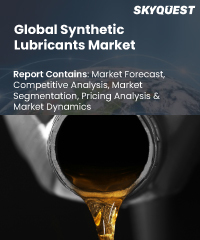
Report ID: SQMIG15E2160

Report ID:
SQMIG15E2160 |
Region:
Global |
Published Date: July, 2024
Pages:
184
|
Tables:
98 |
Figures:
76
Global Synthetic Lubricants market size was valued at USD 17.87 billion in 2022 and is poised to grow from USD 18.60 billion in 2023 to USD 25.66 billion by 2031, at a CAGR of 4.1% during the forecast period (2024-2031).
Synthetic lubricants, such as esters and poly alpha olefin (PAO), are lubricants manufactured from synthetic base oils that take the place of mineral oil generated from crude oil. Market expansion is attributable to synthetic lubricants' improved qualities, which include helping to regulate temperature by absorbing heat produced by moving vehicle parts and transferring it to a cooler or sump. Its demand in end-use industries including the automotive and industrial machinery and equipment sectors is being driven by this. When compared to mineral lubricants, synthetic lubricants have superior qualities, such as greater hardware compatibility with vehicle parts. Hence, the introduction of modern engines and high-end automotive parts, upgrades in vehicle designs, and the improvement of technology are increasing the need for synthetic lubricants over the forecast period.
The demand for the product is also anticipated to expand in Asia Pacific as a result of rising auto production and new machine installations. The need for synthetic lubricants is also increasing as a result of technological developments like the NSF Food lubricants standard, which is being adopted by key equipment manufacturers in the food sector for the use of synthetic lubricants. New goods and technologies are being developed by manufacturers so that they may be used with a variety of machinery that operates at high pressures and temperatures. The preference of consumers for less expensive alternatives to synthetic lubricants, however, is anticipated to restrain market expansion. The range of synthetic lubricants is also anticipated to be reduced due to the growing demand to lower maintenance costs in the manufacturing sector. Future market expansion is also anticipated to be hampered by the incompatibility of conventional mineral oils and polyalkylene glycol (PAG)-based oils with polyalphaolefins (PAOs) and PAOs.
US Synthetic Lubricants Market is poised to grow at a sustainable CAGR for the next forecast year.
Our industry expert will work with you to provide you with customized data in a short amount of time.
REQUEST FREE CUSTOMIZATIONWant to customize this report? This report can be personalized according to your needs. Our analysts and industry experts will work directly with you to understand your requirements and provide you with customized data in a short amount of time. We offer $1000 worth of FREE customization at the time of purchase.

Report ID: SQMIG15E2160